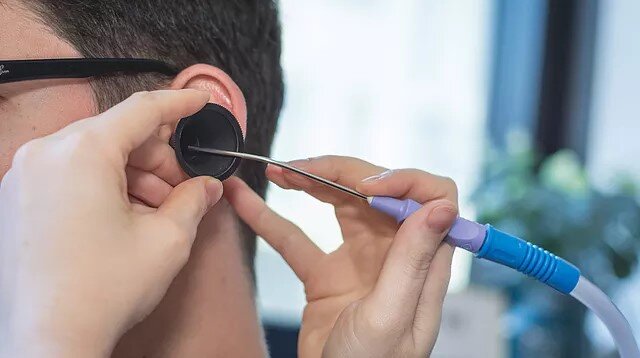Earwax removal is the method of removing any excess earwax which has built up in the ear canal. This process may be needed if someone is suffering from hearing loss, ear infections or ear irritation.
Earwax removal done by a professional is recommended to prevent damage being caused to the ear, in addition to making sure all of the built-up earwax is removed effectively. There are various methods of removing earwax, with certain procedures being better suited to certain people and their individual needs.
In this blog, we will cover the three main methods of earwax removal.
Endoscopic Wax Microsuction
Endoscopic wax microsuction is a modern and effective method of earwax removal which involves the use of an endoscope on the end of a small suction device. The endoscope allows the hearing specialist to easily view where the earwax buildup is inside the ear, so they know where to place the microsuction machine. The microsuction machine is almost like a small vacuum, built to fit easily into the ear, and has a strong enough suction to remove earwax without causing any damage to the inside of the ear. As the device allows the hearing specialist to see where they are removing the earwax from, it makes microsuction one of the safest methods of earwax removal.
The endoscope allows a clear view of the inside of the ear canal allowing the specialist to have a good field of vision of where they are placing the suction machine inside of the ear. The endoscope itself is not large inside of the ear and therefore, will not cause any irritation or discomfort to the patient. Alongside this, the microsuction tool should create nothing more than a tickling sensation. Since there is little discomfort, microsuction is suitable for all ages. Moreover, this method is safe for those who need to avoid getting water inside their ear. Whether you are prone to ear infections from water or have suffered from previous issues during irrigation with water, microsuction is highly recommended as you can still receive earwax removal without causing any further problems.
Overall this method should be fast and almost completely painless, but if you do feel any discomfort you should alert your doctor immediately. Because of the safety and efficiency of this earwax removal method, it can be carried out as often as needed. However, your ear canal is recommended to be cleared every 4-6 months if you often suffer from earwax buildup. This time period can vary depending on the speed of the build-up.
Although this method is seen as the safest method of earwax removal there are always risks with any medical procedure. Complications regarding endoscopic wax microsuction often include dizziness and temporary hearing loss. These complications only occur on rare occasions however, if suffering from any discomfort during the removal you should alert your hearing specialist straight away. Moreover, if experiencing any dizziness or hearing loss after the treatment also ensure you inform the audiologist..

Manual Wax Removal
Manual wax removal is the removal of built-up earwax in the outer ear canal through the use of tools rather than a machine or water. A hearing specialist will directly look into the ear canal and then insert specialised instruments into the ear canal to remove excessive earwax. This procedure can be a benefit if the built-up earwax is too solid to be removed by microsuction or too deep for water to be shot behind it using the irrigation method.
Manual wax removal is recommended for those who have a narrower ear canal or when other methods have failed, as explained above. This method is also suitable for those who suffer from tinnitus as no sound will be created whilst the procedure is carried out.
This procedure can remove a large amount of earwax and is only recommended every six months or so. However, depending on the proneness of earwax buildup you may need to undergo removal after just a few months. Consider booking a check-up with your audiologist to get a recommendation on when your ears should next be cleaned.
Of course with all procedures, there is a risk. With manual removal, there is a risk of ear infections as tools are being placed inside the ear. However, ensuring the equipment is thoroughly cleaned beforehand should negate this risk.

Ear Irrigation
Finally, ear irrigation is another earwax removal method. This method consists of inserting liquid into the ear canal to flush earwax out. The water is directed into the ear canal and the aim is to flush out the earwax with the pressure of the water.
Earwax contains waxy oils produced by dead skin cells. Water and oil repel each other so the pressure of the water combined with its repellant properties means that the wax is removed out of the ear easily. Once the method is complete it is important that the ear is completely dried by either using a towel or a few drops of rubbing alcohol.
This method is best suited to those who have certain medical conditions concerning their ears as well as those who may have had eardrum surgery. Those suffering from hearing loss, chronic coughing, itching or pain may also be recommended this method of wax removal.
This removal procedure is recommended every six months or sooner depending on the proneness of buildup after the procedure.
With any procedure, there can be potential risks. Ear irrigation can sometimes cause dizziness, ear canal discomfort or pain or ringing in the ears. These side effects are fairly common yet it is nothing to be too concerned about. If you experience any of these symptoms during your wax irrigation then tell your doctor immediately.
All of these methods are suitable ways to remove earwax, but should only be performed by a professional. Some methods are better suited to certain people depending on their medical conditions.

If you need ear wax removal, get in touch with us here and we’ll recommend the most suitable procedure.
Image sources:
